Will Pfeifer's Blog, page 39
August 22, 2012
The 100 Favorite Films Project, Part 19: 'Zelig'
I'm running down the list of my 100 favorite movies in no particular order. Join me, won't you?

'Zelig'1983, written and directed by Woody Allen
Well, it's been a while since we've done one of these, hasn't it?
No matter. If there's ever been a movie that transcends the passage of time, "Zelig" is it. Released in 1983 (one year before that other great fake documentary of the early 1980s), it manages to createa completely convincing picture of the 1920s and 1930s, all in a time before computer-generated imagery or other high-tech tricks. In fact, I'd argue that Allen's comparatively low-tech film is the most believable, most visually adept mock-documentary I've ever seen. Somehow, using a combination of blue-screens, actual footage, dead-on recreations and antique equipment and techniques, Allen and company are able to convince us that, one upon a time, there really was a man named Leonard Zelig who changed his appearance to mimic the people around him.
I don't mean to dwell on the technical aspects of "Zelig," because it's much more than just a special effects wonder. But those effects are what makes it possible to slip so effortlessly into the movie's fictional past. When we see Zelig being serenaded by Fanny Brice, or standing by Babe Ruth in batting practice, or disrupting a Nazi rally by waving at his girlfriend, you'd swear it really happened. The illusion of being an actual documentary is enhanced by the modern-day segments, which feature actual big-name intellectuals like Susan Sontag and Saul Bellow weighing-in on the sociological implications of Zelig's life and popularity. The fact that they seem to be taking the whole thing seriously means we do to.
That's not to say "Zelig" isn't funny, though. It's full of the sort of deadpan, absurdist humor that made Woody Allen a household name. After a scandalous period where Leonard "became" dozens of different people and caused chaos all over the map, he makes several apologies, including this one: "And to the, to the gentleman who's appendix I took out, I...I'm, I don't know what to say, if it's any consolation I... I may still have it somewhere around the house." And, Woody being Woody, there's this bit from the narrator: "To the Ku Klux Klan, Zelig, a Jew who could turn himself into a Negro and an Indian, he was a triple threat."
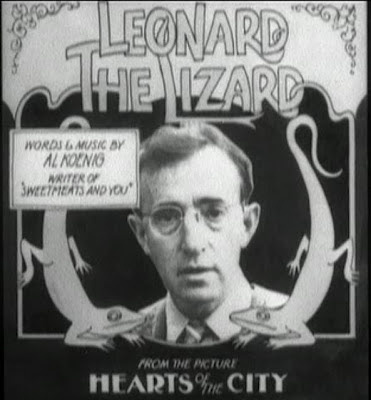
Even better, though, are the various songs, toys and other artifacts of Leonard Zelig's long-ago popularity. The tunes -- "Leonard the Lizard," "Reptile Eyes," "You May Be Six People, But I Love You" -- are both catchy and authentic-sounding, and the toys glimpsed in various faux film clips are period-perfect. (I actually saw some of the props themselves years ago at the Museum of the Moving Image in Astoria and, unlike most props, they looked real even in person.) There are also clips from "The Changing Man," the fictionalized account of Zelig's life released by Warner Bros. in the mid-1930s. Like everything else in the film, it's a pitch-perfect recreation.
But, like most Woody Allen movies, there's a serious point behind all the smart silliness. Leonard's relationship with the doctor who discovered him (played, of course, by Mia Farrow), is genuinely touching and played straight. And near the end, when Zelig goes missing, he's finally spotted in a newsreel shot in Nazi Germany. As one of the intellectual talking heads points out, that's where a desperation to conform ultimately leads. It ends on a funny note, with Hitler getting mad about a joke he couldn't tell and Zelig flying upside down over the Atlantic, but the serious undertone sticks in your head past the closing credits.
"Zelig" hit theaters in 1983, followed by "Broadway Danny Rose," "The Purple Rose of Cairo," "Hannah and Her Sisters" and "Radio Days." It was arguably Woody's strongest period, and it all started with a forgotten guy nicknamed Leonard the Lizard.

'Zelig'1983, written and directed by Woody Allen
Well, it's been a while since we've done one of these, hasn't it?
No matter. If there's ever been a movie that transcends the passage of time, "Zelig" is it. Released in 1983 (one year before that other great fake documentary of the early 1980s), it manages to createa completely convincing picture of the 1920s and 1930s, all in a time before computer-generated imagery or other high-tech tricks. In fact, I'd argue that Allen's comparatively low-tech film is the most believable, most visually adept mock-documentary I've ever seen. Somehow, using a combination of blue-screens, actual footage, dead-on recreations and antique equipment and techniques, Allen and company are able to convince us that, one upon a time, there really was a man named Leonard Zelig who changed his appearance to mimic the people around him.
I don't mean to dwell on the technical aspects of "Zelig," because it's much more than just a special effects wonder. But those effects are what makes it possible to slip so effortlessly into the movie's fictional past. When we see Zelig being serenaded by Fanny Brice, or standing by Babe Ruth in batting practice, or disrupting a Nazi rally by waving at his girlfriend, you'd swear it really happened. The illusion of being an actual documentary is enhanced by the modern-day segments, which feature actual big-name intellectuals like Susan Sontag and Saul Bellow weighing-in on the sociological implications of Zelig's life and popularity. The fact that they seem to be taking the whole thing seriously means we do to.
That's not to say "Zelig" isn't funny, though. It's full of the sort of deadpan, absurdist humor that made Woody Allen a household name. After a scandalous period where Leonard "became" dozens of different people and caused chaos all over the map, he makes several apologies, including this one: "And to the, to the gentleman who's appendix I took out, I...I'm, I don't know what to say, if it's any consolation I... I may still have it somewhere around the house." And, Woody being Woody, there's this bit from the narrator: "To the Ku Klux Klan, Zelig, a Jew who could turn himself into a Negro and an Indian, he was a triple threat."

Even better, though, are the various songs, toys and other artifacts of Leonard Zelig's long-ago popularity. The tunes -- "Leonard the Lizard," "Reptile Eyes," "You May Be Six People, But I Love You" -- are both catchy and authentic-sounding, and the toys glimpsed in various faux film clips are period-perfect. (I actually saw some of the props themselves years ago at the Museum of the Moving Image in Astoria and, unlike most props, they looked real even in person.) There are also clips from "The Changing Man," the fictionalized account of Zelig's life released by Warner Bros. in the mid-1930s. Like everything else in the film, it's a pitch-perfect recreation.
But, like most Woody Allen movies, there's a serious point behind all the smart silliness. Leonard's relationship with the doctor who discovered him (played, of course, by Mia Farrow), is genuinely touching and played straight. And near the end, when Zelig goes missing, he's finally spotted in a newsreel shot in Nazi Germany. As one of the intellectual talking heads points out, that's where a desperation to conform ultimately leads. It ends on a funny note, with Hitler getting mad about a joke he couldn't tell and Zelig flying upside down over the Atlantic, but the serious undertone sticks in your head past the closing credits.
"Zelig" hit theaters in 1983, followed by "Broadway Danny Rose," "The Purple Rose of Cairo," "Hannah and Her Sisters" and "Radio Days." It was arguably Woody's strongest period, and it all started with a forgotten guy nicknamed Leonard the Lizard.
Published on August 22, 2012 19:57
August 18, 2012
Will Elder Weekends: Will and Harvey, Harvey and Will
Here's a nice portrait of two icons of satire, Will Elder and Harvey Kurtzman, photographed sometime in the 1960s and looking slightly more serious than normal.

I was lucky enough to meet Harvey at a Chicago Comicon in the early 1990s, and he signed a few books for me, including the Kitchen Sink collection of the "Goodman Beaver" strip he and Elder created for Help. Kurtzman's inscription reads "Regards from Harvey Kurtzman to Will and Will -- So many Wills! It's so confusing!" I never got to meet Will Elder and have him sign the same book, unfortunately, but I suppose that signature of Harvey's is the next best thing.


I was lucky enough to meet Harvey at a Chicago Comicon in the early 1990s, and he signed a few books for me, including the Kitchen Sink collection of the "Goodman Beaver" strip he and Elder created for Help. Kurtzman's inscription reads "Regards from Harvey Kurtzman to Will and Will -- So many Wills! It's so confusing!" I never got to meet Will Elder and have him sign the same book, unfortunately, but I suppose that signature of Harvey's is the next best thing.
Published on August 18, 2012 13:21
August 16, 2012
From the Bookshelves: 'Nightmare USA'
Fourth in a series of random, rambling explorations of my library.
Three things you should know about me: I love books, I love strange movies and, most of all, I love books about strange movies. Just a couple of entries ago in this series, I wrote about "Sleazoid Express," which focused on all the oddball films that played in Times Square during its disreputable heyday. This time, the focus falls on Stephen Thrower's epic tome "Nightmare Alley: The Untold Story of the Exploitation Independents."
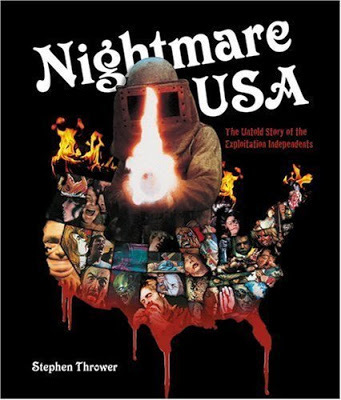
The subject matter is similar, but there's surprisingly little overlap, mostly because Thrower writes mostly about movies that had even lower budgets and were even more obscure than the forgotten films "Sleazoid Express" celebrates. Ever hear of "Scream Bloody Murder" or "Screams of a Winter Night"? How about "Premonition" or "The Forest"? Well, surely you've heard of "Friday the 13th," right? No, not that one. The one I'm talking about -- and the one Thrower writes about -- came out in 1977 (three years before the one you've seen) and has the full title of "Friday The 13th: The Orphan."
Don't feel left out. I've been plumbing these depths for years, and I've barely heard of any of the films in "Nightmare USA" -- and I've only seen a handful. That's what makes Thrower's book so fascinating, at least to an exploitation film geek like me. These movies are so obscure that, in a practical sense, they barely exist. But Thrower does more than just jot down a quick synopsis and paste up a few blurry photos. He goes in-depth in his coverage, offering detailed reviews, extensive making-of stories and surprisingly revealing (and often very funny) interviews with the cast and crew. It's one of the most amazing feats of cinematic archaeology I've ever seen.
What's more, "Nightmare USA" is a BIG book, more than 500 pages with small type (and large images) on every page. I've had it for years, but I'm not even close to having completely read it. I just pick it up every so often (and believe me, that's not as easy as it sounds -- this book is heavy) and page through, looking for something to catch my eye. With chapters devoted to "Death Bed: The Bed That Eats" and "Don't Go in the House," that usually doesn't take long. I have read Thrower's introduction, titled "The Exploitation Independents," more than once, largely because it's the most concise, most entertaining history of the genre I've ever seen. And, taking up more than 35 pages of small type (in two columns per page), it's practically a book all by itself.
Obviously, this isn't the sort of book that's going to find a home on most coffee tables. Yes, it's well-written and nicely designed, but it's also creepy, gory and occasionally disturbing. For all those reasons -- and a whole lot more -- it's found a home on mine. On the last page of the book, Thrower teases us with plans for a Volume 2. It's been five years since Volume 1 hit the stands, but I'm willing to be patient. A book like this must've taken a lifetime to complete.
Three things you should know about me: I love books, I love strange movies and, most of all, I love books about strange movies. Just a couple of entries ago in this series, I wrote about "Sleazoid Express," which focused on all the oddball films that played in Times Square during its disreputable heyday. This time, the focus falls on Stephen Thrower's epic tome "Nightmare Alley: The Untold Story of the Exploitation Independents."

The subject matter is similar, but there's surprisingly little overlap, mostly because Thrower writes mostly about movies that had even lower budgets and were even more obscure than the forgotten films "Sleazoid Express" celebrates. Ever hear of "Scream Bloody Murder" or "Screams of a Winter Night"? How about "Premonition" or "The Forest"? Well, surely you've heard of "Friday the 13th," right? No, not that one. The one I'm talking about -- and the one Thrower writes about -- came out in 1977 (three years before the one you've seen) and has the full title of "Friday The 13th: The Orphan."
Don't feel left out. I've been plumbing these depths for years, and I've barely heard of any of the films in "Nightmare USA" -- and I've only seen a handful. That's what makes Thrower's book so fascinating, at least to an exploitation film geek like me. These movies are so obscure that, in a practical sense, they barely exist. But Thrower does more than just jot down a quick synopsis and paste up a few blurry photos. He goes in-depth in his coverage, offering detailed reviews, extensive making-of stories and surprisingly revealing (and often very funny) interviews with the cast and crew. It's one of the most amazing feats of cinematic archaeology I've ever seen.
What's more, "Nightmare USA" is a BIG book, more than 500 pages with small type (and large images) on every page. I've had it for years, but I'm not even close to having completely read it. I just pick it up every so often (and believe me, that's not as easy as it sounds -- this book is heavy) and page through, looking for something to catch my eye. With chapters devoted to "Death Bed: The Bed That Eats" and "Don't Go in the House," that usually doesn't take long. I have read Thrower's introduction, titled "The Exploitation Independents," more than once, largely because it's the most concise, most entertaining history of the genre I've ever seen. And, taking up more than 35 pages of small type (in two columns per page), it's practically a book all by itself.
Obviously, this isn't the sort of book that's going to find a home on most coffee tables. Yes, it's well-written and nicely designed, but it's also creepy, gory and occasionally disturbing. For all those reasons -- and a whole lot more -- it's found a home on mine. On the last page of the book, Thrower teases us with plans for a Volume 2. It's been five years since Volume 1 hit the stands, but I'm willing to be patient. A book like this must've taken a lifetime to complete.
Published on August 16, 2012 12:20
August 11, 2012
Will Elder Weekends: Elder does Dali!
Here's a piece that originally ran in the June 1959 issue of Pageant magazine (and, like the rest of Elder's rare Pageant work, is reprinted in the highly recommended "Will Elder: The Mad Playboy of Art"). Part of an article titled "How to Understand Modern Art," it spoofs -- obviously -- the work of Salvador Dali.
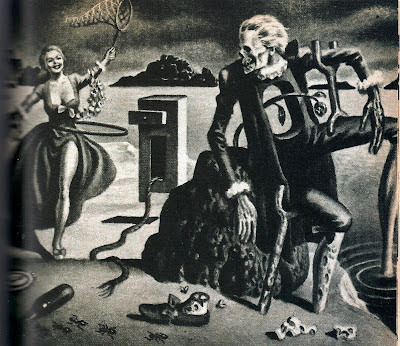
This one really works well because it combines Elder's attention to detail with his killer chops. Anyone could've painted some of those damn melting clocks for a simple Dali spoof, but Elder includes some of the less obvious Dali motifs -- those ants, the crutch, the hole in the figure -- and renders it all beautifully. Dali and Elder were both artists who could conceive of strange, funny, disturbing visions and render them in a completely realistic manner, making the visual impact that much stronger. Judging by this piece, Elder obviously admired Dali's work. I wouldn't be surprised to learn that the opposite was true, too.

This one really works well because it combines Elder's attention to detail with his killer chops. Anyone could've painted some of those damn melting clocks for a simple Dali spoof, but Elder includes some of the less obvious Dali motifs -- those ants, the crutch, the hole in the figure -- and renders it all beautifully. Dali and Elder were both artists who could conceive of strange, funny, disturbing visions and render them in a completely realistic manner, making the visual impact that much stronger. Judging by this piece, Elder obviously admired Dali's work. I wouldn't be surprised to learn that the opposite was true, too.
Published on August 11, 2012 19:16
August 8, 2012
Rest in peas, Marvin Hamlisch. Rest in peas.
As you probably know, legendary composer Marvin Hamlisch died Monday at the age of 68. As you probably don't know -- I mean, really, how could you? -- the first thing that comes to my mind when I hear the words "Marvin Hamlisch" is a little remembered guest appearance he made on David Letterman's show sometime in the early 1990s.
What, you ask, could be so memorable about that guest spot that it supercedes Hamlisch's writing of "Nobody Does It Better" from "The Spy Who Loved Me" in my head? Well, here's your answer....
Now be honest: You're going to have "Pea Boy, can't you see, boy, all the great joy that you spread" running through your skull for weeks! Isn't that better than some damned Streisand tune?

What, you ask, could be so memorable about that guest spot that it supercedes Hamlisch's writing of "Nobody Does It Better" from "The Spy Who Loved Me" in my head? Well, here's your answer....
Now be honest: You're going to have "Pea Boy, can't you see, boy, all the great joy that you spread" running through your skull for weeks! Isn't that better than some damned Streisand tune?
Published on August 08, 2012 18:12
August 4, 2012
Will Elder Weekends: Self portrait with wings
Here's a fun photo our of boy Willie Elder from 1939, when he was 18 years old. The wings and halo are his own addition, proving that more than a decade before he started drawing for MAD, his antic sense of humor was already well established.
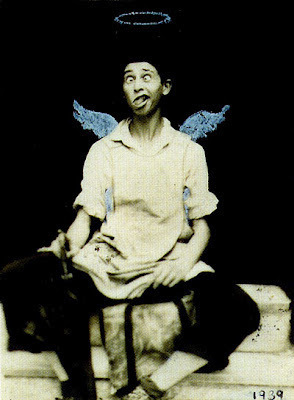
This photo is yet another one from the excellent Fantagraphics book "Will Elder: The Mad Playboy of Art." If you've been enjoying these weekly posts and don't yet own a copy, what the heck is the matter with you?

This photo is yet another one from the excellent Fantagraphics book "Will Elder: The Mad Playboy of Art." If you've been enjoying these weekly posts and don't yet own a copy, what the heck is the matter with you?
Published on August 04, 2012 10:57
August 2, 2012
Movies I watched in July
Even as Amy and I barreled through not one but two seasons of "Game of Thrones," I still found time to watch some movies in the month of July. Which movies, you ask? These movies, I answer:
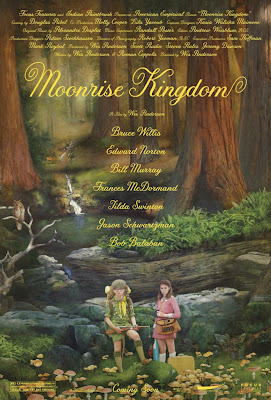
I don't know if this is Wes Anderson's best movie, but it's definitely his most Wes Anderson-esque movie, and I mean that as a compliment. All his themes of alienation, regret, longing and fantasy are present, along with some of the most beautiful sets and cinematography I've seen in years. (I wish I could live in the house the camera moves through in the opening scene.) And, in a cast of very big names -- Willis, Murray, Norton, Keitel, McDormand -- Jared Gilman and Kara Hayward, the two unknown young leads, completely and effortlessly steal the show.
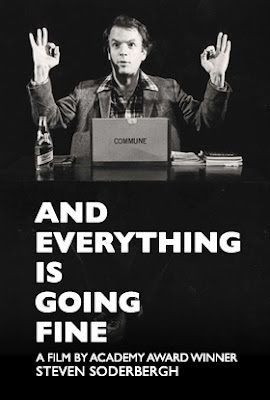
Monologist Spalding Gray gets a posthumous tribute from none other than Steven Soderbergh in this documentary recently released by the fine folks at Criterion. With no narration or any of the other usual documentary context, "And Everything Is Going Fine" relies completely on interviews and (mostly) performances by Gray to tell his life story. It's a fine film, but it lacks the crazy intensity of Gray's best movie, "Swimming to Cambodia."
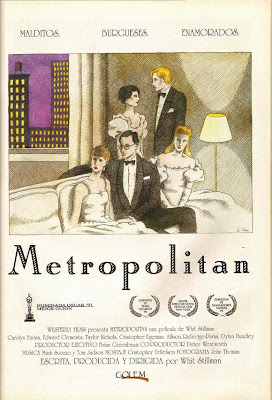
Speaking of Criterion, the company re-released two of writer/director Whit Stillman's movies on Blu-ray this month, including his 1990 debut. I saw it way back then on some pan-and-scanned videotape, and it's much more enjoyable this way, even if the high-def picture hints at just how amazingly low Stillman's budget really was. It's the characters and dialogue that make this movie memorable, with a group of impossibly young rich kids facing their seemingly promising futures with no small amount of trepidation. Funny, smart and oddly touching, it's the sort of movie I like to watch just so I can spend a couple of hours hanging out in this world with these people.
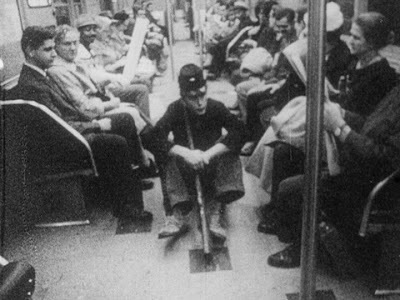
Before he became known as the father of Iron Man, Robert Downey Sr. (A Prince) was an avant garde filmmaker specializing in (very) strange conceptual comedies. Five of his early films were collected by Criterion (them again!) on the Eclipse set "Up All Night with Robert Downey Sr." So far, the only one I've watched is "No More Excuses," a bizarre (to say the least) 1968 effort that combines interviews in singles bars, noted Hoaxer Alan Abel calling for animals to be clothed, a weird romance between two weird people and a Civil War solder (Downey himself, shown above) hanging out in (then) modern day New York. Strange, to be sure, but strangely entertaining, too.
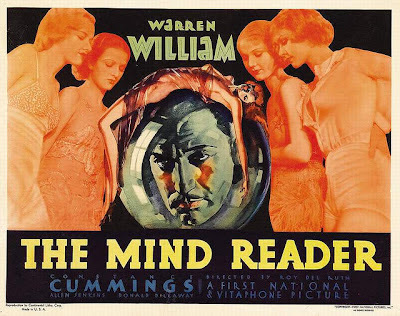
Spend more than five minutes on this blog and you'll realize how much I love the pre-Code movies of the early 1930s. Warner Archives released two more volumes in its Forbidden Hollywood series, and I sampled a few of the films. First up was "The Mind Reader" starring the late, great (and sadly forgotten) Warren William and a phony psychic. It's a lot of fun and a great showcase for Willam's arrogant brand of acting, but don't let that poster fool you -- it's nowhere near that risque.
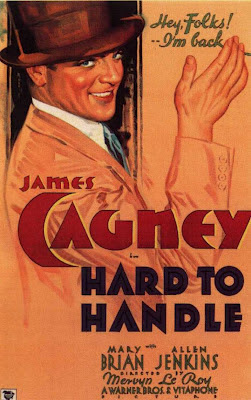
Also included in the Forbidden Hollywood set was this Cagney gem from 1933, where Jimmy plays a gleefully unscrupulous public relations man looking to make a quick buck any way he can. Our hero causes not one but two riots in the course of the movie, and when hired by two guys to promote their seaside boardwalk, he winds up causing a crowd to literally tear it to pieces. But, because it's Cagney at arguably the height of his fast-talking charisma, we don't just forgive him, we cheer him on.
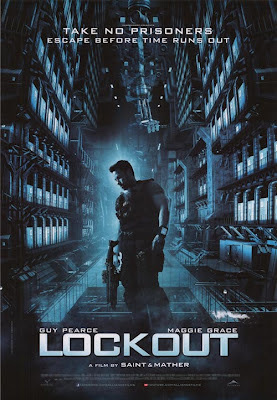
Confession time: I suspected this movie would be awful, but I insisted on renting it because, back when I was a kid drawing comic books, one of the elements I included was a satellite prison in orbit around the Earth. As I got older, I realized the jaw-dropping impracticality of such an idea, but apparently Luc Besson and the makers of this movie never did, because that's exactly the premise used here. They also didn't realize that, if you're going to go to the trouble of hiring Guy Pearce to play your hero, you should probably give him something more than tenth-generation "Die Hard" catchphrases to mutter under his breath. It's the least you can do.
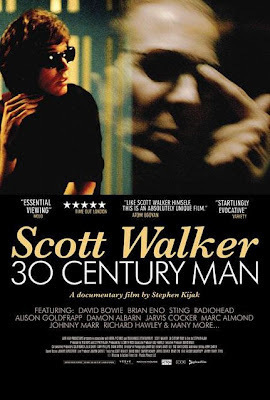
Of the two other documentaries I watched this month, this was the more fascinating -- and no, not because it's about the governor of Wisconsin. This Scott Walker was a popular rock 'n' roller back in the late 1960s and 1970s, first as a member of the Walker Brothers (in true rock form, they weren't brothers and they weren't named "Walker") then as a solo artist. I confess I'd never heard of him, but seeing the story of how he fell into obscurity and re-emerged as a daringly experimental musician was compelling. The fact that, as strange as his music is these days, Walker himself seems a level-headed sort of chap, made it even better.
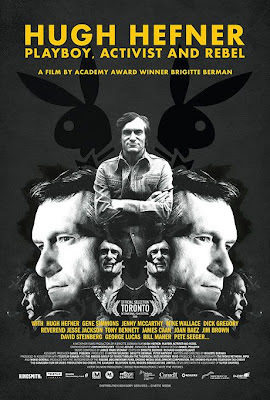
There's certainly an interesting story to be told about the life and career of Hugh Hefner, but unfortunately, this 2009 doc doesn't tell it, instead being satisfied with repeating the same old anecdotes and polishing the same old legend. Footage from those old "Playboy After Dark" shows is always fun to watch, but when Hef and his mag slide into the swinging '70s, everything loses that "Mad Men" cool and starts to look a bit seedy. Even the cavalcade of naysayers the movie employs (Pat Boone? Really?) fail to add any spice to the proceedings. But I guess it beats watching the mind-numbing travesty that is (was?) "The Girls Next Door."

I don't know why this movie doesn't get more attention. Sure, it bombed, and sure, the story is simplistic to the point of being a page in a connect-the-dots book, but as a visual experience it's mind-blowing. The Wachowskis followed their "Matrix" trilogy with this candy-colored explosion of a movie that retells the story of beloved Japanese auto enthusiast Speed Racer (Emile Hirsch, following a slightly more serious turn in "Into the Wild"). Every frame of this movie blasts off the screen, and the races -- though gleefully impossible -- are wonders of computer animation. I picked the Trixie poster, incidentally, because as this movie proves once and for all, Christina Ricci is an anime heroine come to three-dimensional life.
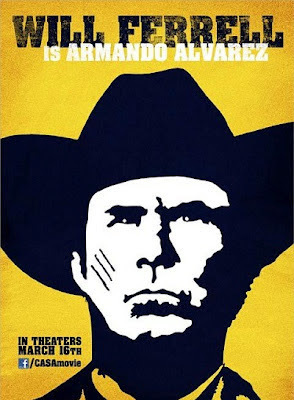
Say what you will about Will Ferrell, but the man is willing to go further for a laugh than most other mortals. Case in point, "Casa de mi Padre," a 2012 comedy that tells a tale of murder and revenge south of the border .... and is entirely in Spanish. The fact that Ferrell isn't nearly as fluent in the language as his castmates is part of the joke, and his dialogue almost feels like something from a Spanish 101 reader. Somehow, though, the joke works, and "Casa de mi Padre" is consistently funny. The wildly fake mountain lion spirit animal doesn't hurt, either.

I liked it. A lot. And though I was deeply, deeply skeptical, Anne Hathaway was very good as someone who is never called "Catwoman" by name. The ending makes me want to see more, but truth be told, I'm glad Christopher Nolan is ending things with this film. It stands as one of the best -- and least disappointing -- trilogies in movie history.

I don't know if this is Wes Anderson's best movie, but it's definitely his most Wes Anderson-esque movie, and I mean that as a compliment. All his themes of alienation, regret, longing and fantasy are present, along with some of the most beautiful sets and cinematography I've seen in years. (I wish I could live in the house the camera moves through in the opening scene.) And, in a cast of very big names -- Willis, Murray, Norton, Keitel, McDormand -- Jared Gilman and Kara Hayward, the two unknown young leads, completely and effortlessly steal the show.

Monologist Spalding Gray gets a posthumous tribute from none other than Steven Soderbergh in this documentary recently released by the fine folks at Criterion. With no narration or any of the other usual documentary context, "And Everything Is Going Fine" relies completely on interviews and (mostly) performances by Gray to tell his life story. It's a fine film, but it lacks the crazy intensity of Gray's best movie, "Swimming to Cambodia."

Speaking of Criterion, the company re-released two of writer/director Whit Stillman's movies on Blu-ray this month, including his 1990 debut. I saw it way back then on some pan-and-scanned videotape, and it's much more enjoyable this way, even if the high-def picture hints at just how amazingly low Stillman's budget really was. It's the characters and dialogue that make this movie memorable, with a group of impossibly young rich kids facing their seemingly promising futures with no small amount of trepidation. Funny, smart and oddly touching, it's the sort of movie I like to watch just so I can spend a couple of hours hanging out in this world with these people.

Before he became known as the father of Iron Man, Robert Downey Sr. (A Prince) was an avant garde filmmaker specializing in (very) strange conceptual comedies. Five of his early films were collected by Criterion (them again!) on the Eclipse set "Up All Night with Robert Downey Sr." So far, the only one I've watched is "No More Excuses," a bizarre (to say the least) 1968 effort that combines interviews in singles bars, noted Hoaxer Alan Abel calling for animals to be clothed, a weird romance between two weird people and a Civil War solder (Downey himself, shown above) hanging out in (then) modern day New York. Strange, to be sure, but strangely entertaining, too.

Spend more than five minutes on this blog and you'll realize how much I love the pre-Code movies of the early 1930s. Warner Archives released two more volumes in its Forbidden Hollywood series, and I sampled a few of the films. First up was "The Mind Reader" starring the late, great (and sadly forgotten) Warren William and a phony psychic. It's a lot of fun and a great showcase for Willam's arrogant brand of acting, but don't let that poster fool you -- it's nowhere near that risque.

Also included in the Forbidden Hollywood set was this Cagney gem from 1933, where Jimmy plays a gleefully unscrupulous public relations man looking to make a quick buck any way he can. Our hero causes not one but two riots in the course of the movie, and when hired by two guys to promote their seaside boardwalk, he winds up causing a crowd to literally tear it to pieces. But, because it's Cagney at arguably the height of his fast-talking charisma, we don't just forgive him, we cheer him on.

Confession time: I suspected this movie would be awful, but I insisted on renting it because, back when I was a kid drawing comic books, one of the elements I included was a satellite prison in orbit around the Earth. As I got older, I realized the jaw-dropping impracticality of such an idea, but apparently Luc Besson and the makers of this movie never did, because that's exactly the premise used here. They also didn't realize that, if you're going to go to the trouble of hiring Guy Pearce to play your hero, you should probably give him something more than tenth-generation "Die Hard" catchphrases to mutter under his breath. It's the least you can do.

Of the two other documentaries I watched this month, this was the more fascinating -- and no, not because it's about the governor of Wisconsin. This Scott Walker was a popular rock 'n' roller back in the late 1960s and 1970s, first as a member of the Walker Brothers (in true rock form, they weren't brothers and they weren't named "Walker") then as a solo artist. I confess I'd never heard of him, but seeing the story of how he fell into obscurity and re-emerged as a daringly experimental musician was compelling. The fact that, as strange as his music is these days, Walker himself seems a level-headed sort of chap, made it even better.

There's certainly an interesting story to be told about the life and career of Hugh Hefner, but unfortunately, this 2009 doc doesn't tell it, instead being satisfied with repeating the same old anecdotes and polishing the same old legend. Footage from those old "Playboy After Dark" shows is always fun to watch, but when Hef and his mag slide into the swinging '70s, everything loses that "Mad Men" cool and starts to look a bit seedy. Even the cavalcade of naysayers the movie employs (Pat Boone? Really?) fail to add any spice to the proceedings. But I guess it beats watching the mind-numbing travesty that is (was?) "The Girls Next Door."

I don't know why this movie doesn't get more attention. Sure, it bombed, and sure, the story is simplistic to the point of being a page in a connect-the-dots book, but as a visual experience it's mind-blowing. The Wachowskis followed their "Matrix" trilogy with this candy-colored explosion of a movie that retells the story of beloved Japanese auto enthusiast Speed Racer (Emile Hirsch, following a slightly more serious turn in "Into the Wild"). Every frame of this movie blasts off the screen, and the races -- though gleefully impossible -- are wonders of computer animation. I picked the Trixie poster, incidentally, because as this movie proves once and for all, Christina Ricci is an anime heroine come to three-dimensional life.

Say what you will about Will Ferrell, but the man is willing to go further for a laugh than most other mortals. Case in point, "Casa de mi Padre," a 2012 comedy that tells a tale of murder and revenge south of the border .... and is entirely in Spanish. The fact that Ferrell isn't nearly as fluent in the language as his castmates is part of the joke, and his dialogue almost feels like something from a Spanish 101 reader. Somehow, though, the joke works, and "Casa de mi Padre" is consistently funny. The wildly fake mountain lion spirit animal doesn't hurt, either.

I liked it. A lot. And though I was deeply, deeply skeptical, Anne Hathaway was very good as someone who is never called "Catwoman" by name. The ending makes me want to see more, but truth be told, I'm glad Christopher Nolan is ending things with this film. It stands as one of the best -- and least disappointing -- trilogies in movie history.
Published on August 02, 2012 19:39
August 1, 2012
Boop Boop a -- WHAT THE @#$%?!?
Among old movie geeks (like, ahem, yours truly) the big bit of under-the-radar news on the Internet lately was the announcement that Olive Films is going to release a long list of classic Betty Boop cartoons on DVD. (The DVD Savant himself, Glenn Erickson, has more details in his July 28 column.)
If you're only familiar with Betty Boop from the ten billion kitschy retro cookie jars, neon signs and T-shirts bearing her (admittedly) freakish visage, this might not sound like a big deal. But to old movie geeks (again, like yours truly) and animation fans (likewise), this is indeed major news. In the early 1930s, Fleischer Studios (led by Max Fleischer) released a series of Betty Boop cartoons that were very, very popular and very, very strange. Eight decades or so later, they look even stranger.
How strange? Here's one of the more well-known cartoons in the Betty Boop series, with some wonderfully archaic animation and surprisingly nightmarish imagery. Take a look. If you don't want to watch the whole thing (it's about eight minutes long), just zip ahead to the 4:20 mark...
Yes, as a matter of fact, that is legendary bandleader Cab Calloway as a ghostly walrus, singing his big hit "Minnie the Moocher" (almost 50 years before he performed it in "The Blues Brothers"). And yes, Cab not only provided the vocals, but the Fleischer animators rotoscoped the character to mimic his distinctive movements. (Rotoscoping involves tracing footage of an actor onto animation cels frame by frame. It's a process Fleischer developed, which was then apparently, ahem, borrowed by a certain other animation company whose biggest star was a mouse.)
As you can tell by the clip above, the Fleischer cartoons had a jazzier, more urban feel than their counterparts at Disney, and though they're not nearly as slick, they're a lot more fun and, as a bonus, offer a fascinating peek back at Depression-era pop culture. Most of the (excellent) Fleischer Popeye cartoons have been released on DVD, and the (even better) Superman cartoons are available as bonus features on the DVD and Blu-ray releases of the movies "Superman" and "Superman II." But aside from some slapdash public-domain collections, the Betty Boop cartoons have never gotten their due, and they're arguably the strangest and most interesting of the bunch. I haven't heard anything about a release date or content list yet, but once I get that info, I'll be sure to share it here at X-Ray Spex.
If you're only familiar with Betty Boop from the ten billion kitschy retro cookie jars, neon signs and T-shirts bearing her (admittedly) freakish visage, this might not sound like a big deal. But to old movie geeks (again, like yours truly) and animation fans (likewise), this is indeed major news. In the early 1930s, Fleischer Studios (led by Max Fleischer) released a series of Betty Boop cartoons that were very, very popular and very, very strange. Eight decades or so later, they look even stranger.
How strange? Here's one of the more well-known cartoons in the Betty Boop series, with some wonderfully archaic animation and surprisingly nightmarish imagery. Take a look. If you don't want to watch the whole thing (it's about eight minutes long), just zip ahead to the 4:20 mark...
Yes, as a matter of fact, that is legendary bandleader Cab Calloway as a ghostly walrus, singing his big hit "Minnie the Moocher" (almost 50 years before he performed it in "The Blues Brothers"). And yes, Cab not only provided the vocals, but the Fleischer animators rotoscoped the character to mimic his distinctive movements. (Rotoscoping involves tracing footage of an actor onto animation cels frame by frame. It's a process Fleischer developed, which was then apparently, ahem, borrowed by a certain other animation company whose biggest star was a mouse.)
As you can tell by the clip above, the Fleischer cartoons had a jazzier, more urban feel than their counterparts at Disney, and though they're not nearly as slick, they're a lot more fun and, as a bonus, offer a fascinating peek back at Depression-era pop culture. Most of the (excellent) Fleischer Popeye cartoons have been released on DVD, and the (even better) Superman cartoons are available as bonus features on the DVD and Blu-ray releases of the movies "Superman" and "Superman II." But aside from some slapdash public-domain collections, the Betty Boop cartoons have never gotten their due, and they're arguably the strangest and most interesting of the bunch. I haven't heard anything about a release date or content list yet, but once I get that info, I'll be sure to share it here at X-Ray Spex.
Published on August 01, 2012 05:35
July 29, 2012
Will Elder Weekends: Meet the staff!
Here's a photo that appeared in the second issue of Harvey Kurtzman's brilliant but ill-fated satire magazine Trump, which hit the stands in March 1957 and was, alas, the last issue.
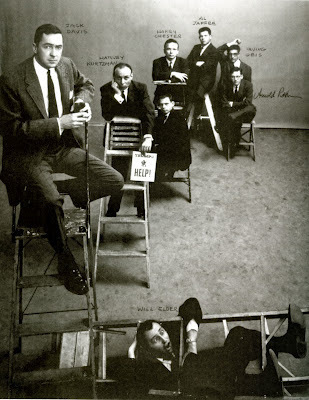
The folks pictured, in case you can't read the hand-written notes, are legendary (and still living) cartoonist Jack Davis on the ladder up front, Harvey himself holding a copy of the first issue of Trump, assistant art director Arnie Lewis next to Harvey, business manager Harry Chester above him, Al Jaffee (creator of the MAD fold-ins, among other things) next to Chester, Irving Geis (sorry -- not quite sure who he is) with his arm over his head and cartoonist Arnold Roth with his legs crossed. And, of course, in the foreground trapped in a ladder, is our boy Will, ever the clown.

The folks pictured, in case you can't read the hand-written notes, are legendary (and still living) cartoonist Jack Davis on the ladder up front, Harvey himself holding a copy of the first issue of Trump, assistant art director Arnie Lewis next to Harvey, business manager Harry Chester above him, Al Jaffee (creator of the MAD fold-ins, among other things) next to Chester, Irving Geis (sorry -- not quite sure who he is) with his arm over his head and cartoonist Arnold Roth with his legs crossed. And, of course, in the foreground trapped in a ladder, is our boy Will, ever the clown.
Published on July 29, 2012 06:30
July 28, 2012
The braying sheep on the TV screen make this boy shout, make this boy scream
If you watched the opening ceremonies of the London Olympics last night -- and if you listened carefully -- you might have heard a snippet of "Going Underground," the classic 1980 song by the British band The Jam. As with many (most? all?) of Paul Weller's songs, the lyrics have more than a slight political edge to them. For instance, there's this...
"I'm so happy and you're so kind
You want more money, of course I don't mind
To buy nuclear textbooks for atomic crimes.
And the public gets what the public wants,
But I want nothing this society's got.
I'm going underground (going underground)"
And then, a little later, there's this...
"What you see is what you get.
You've made your bed, you better lie in it.
You choose your leaders and place their trust
As their lies wash you down and their promises rust.
You'll see kidney machines replaced by rockets and guns."
I think you get the idea, but just in case, here's the vintage video of the band performing the song, complete with the sort of political image montage and stock footage of atomic tests you don't see much these days. Hey, it was the (very) early '80s after all...
So what's my point? I don't really have much of one, I suppose, except for having a timely excuse to share one of the truly great songs of the postpunk era. (Catchy as hell, isn't it?) I mean, of course, it's yet another example of a subversive song having its own meaning subvertied by being played in a rah-rah context, but that's nothing new. "Born in the U.S.A," a harrowing tale of a Vietnam vet struggling to cope somehow became a GOP rallying tune in the 1980s, and Iggy Pop's 1977 song "Lust for Life," which actually contains the lines "Here comes Johnny Yen again / with the liquor and drugs / and the flesh machine / He's gonna do another strip tease," was used to sell family-friendly cruise vacations for years. And I'm sure Iggy cashed each and every one of those checks. He's a Detroit boy. He knows how a product gets sold.
The man who revived "Lust for Life" in the 1990s was director Danny Boyle, who used it in the opening moments of his 1996 movie, "Trainspotting." Here's the first 26 seconds of that movie, featuring the tune playing in the background. Tell me it's not used perfectly, and then tell me if you were in the ad biz, you wouldn't immediately start thinking of ways to use it in a campaign. (There's one dirty word in Ewan McGregor's narration, so consider yourself warned, but don't be surprised -- it's a movie about Scottish heroin addicts, after all).
Boyle, of course, is the guy who masterminded last night's opening ceremonies of the London Olympics, and his use of "Going Underground" (not to mention a snippet of footage from "Trainspotting") was part of an attempt to collapse a few thousand years of British culture into an hour or so. I don't think it was entirely successful, but I have to admit hearing The Jam or The Kinks or Bowie or Queen echoing out of that stadium was a real kick. I even caught Johnny Rotten screamngi "And we don't caaaaaaaaare" when NBC returned from a commercial break, but that's all we yanks got to hear from the Sex Pistols' "Pretty Vacant." If only they would've played "God Save the Queen" ("she ain't no human being") -- but I suppose that's too much for an aging punk fan to hope for. Danny Boyle may love that music, but he also knows where his bread's buttered.
And anyway, getting back to "Going Underground," at least one line in that song perfectly, if inadvertently, reflected on the evening itself. Every time Bob Costas or Meredith Viera or whoever else NBC paid to sit behind a microphone opened their mouths and blathered on pointlessly, a certain lyric came to mind -- namely, the one that's the title of this blog post.
Paul Weller, even 35 years ago, you knew of what you spoke.

"I'm so happy and you're so kind
You want more money, of course I don't mind
To buy nuclear textbooks for atomic crimes.
And the public gets what the public wants,
But I want nothing this society's got.
I'm going underground (going underground)"
And then, a little later, there's this...
"What you see is what you get.
You've made your bed, you better lie in it.
You choose your leaders and place their trust
As their lies wash you down and their promises rust.
You'll see kidney machines replaced by rockets and guns."
I think you get the idea, but just in case, here's the vintage video of the band performing the song, complete with the sort of political image montage and stock footage of atomic tests you don't see much these days. Hey, it was the (very) early '80s after all...
So what's my point? I don't really have much of one, I suppose, except for having a timely excuse to share one of the truly great songs of the postpunk era. (Catchy as hell, isn't it?) I mean, of course, it's yet another example of a subversive song having its own meaning subvertied by being played in a rah-rah context, but that's nothing new. "Born in the U.S.A," a harrowing tale of a Vietnam vet struggling to cope somehow became a GOP rallying tune in the 1980s, and Iggy Pop's 1977 song "Lust for Life," which actually contains the lines "Here comes Johnny Yen again / with the liquor and drugs / and the flesh machine / He's gonna do another strip tease," was used to sell family-friendly cruise vacations for years. And I'm sure Iggy cashed each and every one of those checks. He's a Detroit boy. He knows how a product gets sold.
The man who revived "Lust for Life" in the 1990s was director Danny Boyle, who used it in the opening moments of his 1996 movie, "Trainspotting." Here's the first 26 seconds of that movie, featuring the tune playing in the background. Tell me it's not used perfectly, and then tell me if you were in the ad biz, you wouldn't immediately start thinking of ways to use it in a campaign. (There's one dirty word in Ewan McGregor's narration, so consider yourself warned, but don't be surprised -- it's a movie about Scottish heroin addicts, after all).
Boyle, of course, is the guy who masterminded last night's opening ceremonies of the London Olympics, and his use of "Going Underground" (not to mention a snippet of footage from "Trainspotting") was part of an attempt to collapse a few thousand years of British culture into an hour or so. I don't think it was entirely successful, but I have to admit hearing The Jam or The Kinks or Bowie or Queen echoing out of that stadium was a real kick. I even caught Johnny Rotten screamngi "And we don't caaaaaaaaare" when NBC returned from a commercial break, but that's all we yanks got to hear from the Sex Pistols' "Pretty Vacant." If only they would've played "God Save the Queen" ("she ain't no human being") -- but I suppose that's too much for an aging punk fan to hope for. Danny Boyle may love that music, but he also knows where his bread's buttered.
And anyway, getting back to "Going Underground," at least one line in that song perfectly, if inadvertently, reflected on the evening itself. Every time Bob Costas or Meredith Viera or whoever else NBC paid to sit behind a microphone opened their mouths and blathered on pointlessly, a certain lyric came to mind -- namely, the one that's the title of this blog post.
Paul Weller, even 35 years ago, you knew of what you spoke.
Published on July 28, 2012 13:58
Will Pfeifer's Blog
- Will Pfeifer's profile
- 23 followers
Will Pfeifer isn't a Goodreads Author
(yet),
but they
do have a blog,
so here are some recent posts imported from
their feed.



